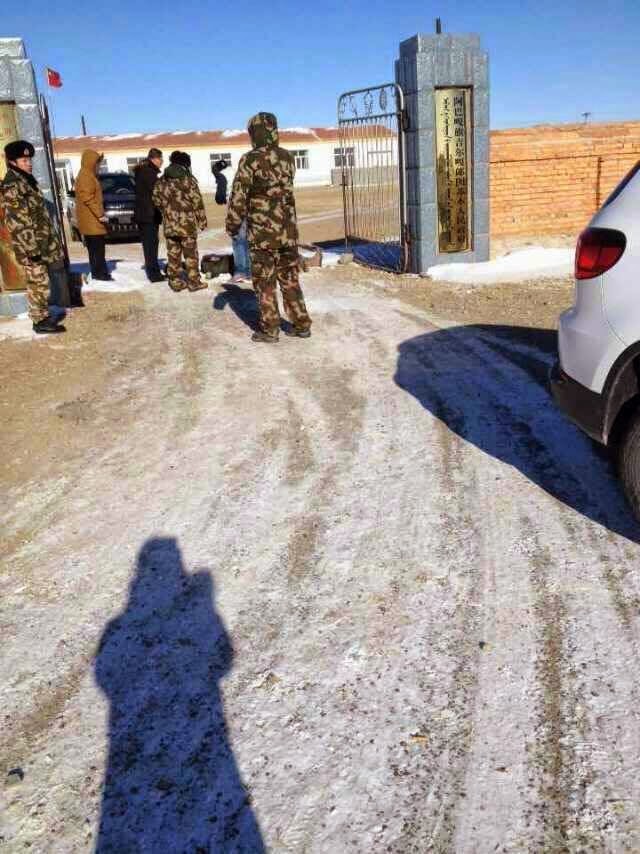Amidst escalating protests by
Mongolian herders in Southern
(Inner) Mongolia, on January 19,
2015, a herder named Mr. Tumur, 45
years old, from Zargalant Sum (“ji
ri ga lang tu sum u” in Chinese) of
Abag Banner (“a ba ga qi”), western
Southern Mongolia, hanged himself to
death from the Sum Government
building gate in protest of the
authorities’ illegal occupation of
his grazing land.
According to written appeals the
Southern Mongolian Human Rights
Information Center (SMHRIC) received
from the deceased’s relatives, Tumur
had been petitioning the local
government for years for the return
of his grazing land illegally
occupied during a “help the poor
initiative.” Relatives revealed that Tumur was active in organizing
herders to demand the government
punishment of corrupt officials and
to provide justice for herders.
Pictures of the suicide scene went
viral on major Chinese social media
outlets, including WebChat, Sina,
and Tencent sites. Mongolian
netizens demanded justice for the
deceased and rallied for the
survival of the Mongolians as a
distinct people.
As the crisis deepened in the
Southern Mongolian rural pastoralist
communities, on the morning of
January 26, 2015, some 300 Mongolian
herders from western Southern
Mongolia’s Durbed Banner (“si zi
wang qi”), Sunid Right Banner (“su
ni te you qi”), Urad
Middle Banner (“wu la te qian qi”),
and Shiliin-hot (“xi lin hao te”) gathered and protested in
front of the Inner Mongolia
Autonomous Region Department of
Agriculture and Animal Husbandry.
Many of the participants were
herders who had protested the
Chinese Central Military Commission
and State Bureau of Letters and
Calls in Beijing since January 11,
2015. They demanded that Chinese
authorities return their land and
redress their losses due to land
grabs by the military base,
extractive industry, and “ecological
migration” policy.
At 10:00 a.m. officials from the
Department of Agriculture and Animal
Husbandry met with the herders’
representatives but failed to meet
their demands. Disgruntled herders
displayed a banner reading “Return
Our Homeland, Return Our Justice”
and requested a solution.
At 3:00 p.m. the herders marched to
the Autonomous Region Government and
demanded the protection of their
rights and a solution to their land
grievances. Police surveillance was
heavy, and a loudspeaker
announcement from the authorities
was played repeatedly to emphasize
“social stability” and “law and
order.”
At 4:00 p.m. herders marched to the
Inner Mongolian People’s Conference
Hall where the “Two Meetings” of the
“Autonomous Region People’s
Congress” and the “People’s
Political Consultative Conference”
were still in session. Some 200
police officers arrived to the scene
and forcefully arrested more than 30
herders. Pictures and video clips
sent to SMHRIC from the scene show
the protesting herders resisting the
arrests and refusing to leave
despite the the police brutality.
“We were thrown into a bus and on
the way to our home Banner,” protest
organizer Mr. Davshilt told SMHRIC.
“Herders are not afraid of being
arrested,” Ms. Naanaa, another
organizer of the protest, told
SMHRIC via audio messenger, “if they
take us back to Durbed Banner, we
will protest in front of the Banner
government.”
The initial protest began January
11, 2015 when some 30 herders from
Durbed Banner and Sunid Right Banner
marched toward Beijing to protest
the Chinese People’s Liberation Army
military base’s occupation of
grazing land. The protest was later
joined by herders from the Urad
Middle Banner and Shiliin-hot areas
after they decided to continue
protesting at the regional capital
Hohhot.
According to communications received
from the affected communities, the
expansion of the Zureh Military
Training Base forced nearly 3,000
herders from more than 800
households to give up their grazing
lands, offering neither proper
compensation nor adequate housing.
Herders from Urad Middle Banner
joined the protest in Hohhot for the
local authorities and mining
companies’ illegal grab of their
grazing lands. Some of them also
complained about police brutality
that left several herders injured in
earlier protests.
Herders from Shiliin-hot area joined
the protest and demanded the
authorities return the land from
which they were forcefully evicted
in 2002 and 2004 as part of the
“Ecological Migration” Project.






 Beyond
Great Walls: Environment, Identity, and Development on the Chinese
Grasslands of Inner Mongolia
Beyond
Great Walls: Environment, Identity, and Development on the Chinese
Grasslands of Inner Mongolia China's
Pastoral Region: Sheep and Wool, Minority Nationalities, Rangeland
Degradation and Sustainable Development
China's
Pastoral Region: Sheep and Wool, Minority Nationalities, Rangeland
Degradation and Sustainable Development The
Ordos Plateau of China: An Endangered Environment (Unu Studies on
Critical Environmental Regions)
The
Ordos Plateau of China: An Endangered Environment (Unu Studies on
Critical Environmental Regions)